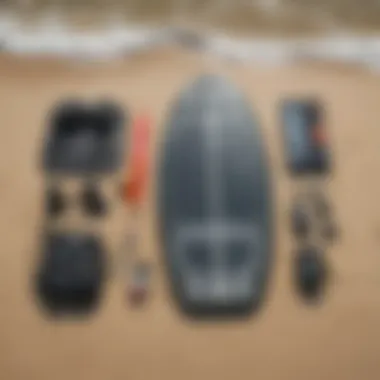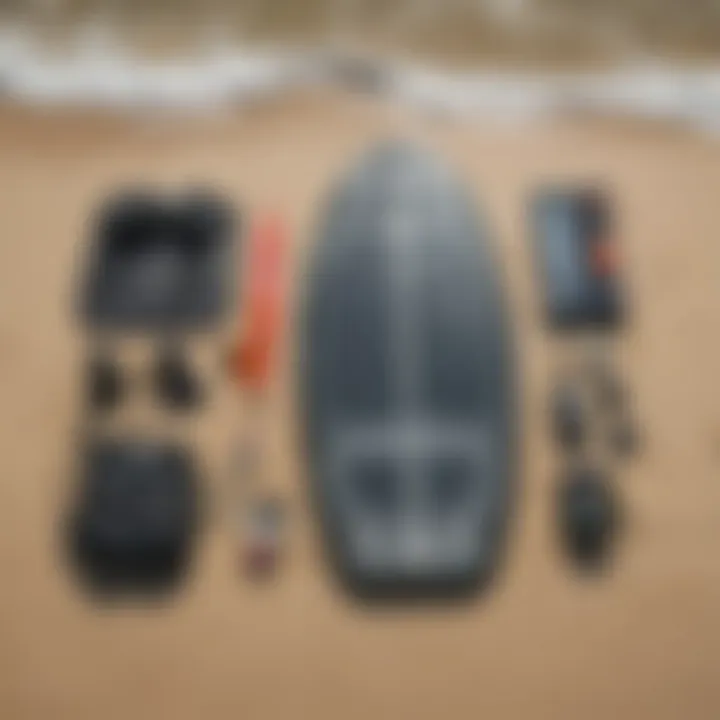Expert Tips for Selecting a Quality Boogie Board


Intro
The allure of gliding atop a wave, the salty breeze in your hair, and the adrenaline rush as you ride the crest is something many strive for. Regardless of whether you’re a budding enthusiast or a seasoned rider, the choice of the right boogie board can significantly influence your experience in the water. Understanding the aspects that constitute a high-quality board is essential. This guide dissects the core components to consider before making your purchase and oh boy, there are quite a few!
Boogie boards, also known as bodyboards, serve as an entry point for many into the thrilling world of wave riding. They can vary tremendously in terms of material, design, performance, and even maintenance. The market can feel like a veritable jungle with options galore, so let's help you cut through the noise to find that's just right for you.
Techniques and Skills
Essential Techniques for Beginners
Starting out with boogie boarding is akin to learning how to ride a bike — it might take a few tumbles before you find your balance. Here are some fundamental techniques for getting the hang of it:
- Positioning: Lie down with your body centered on the board and your feet tucked slightly over the tail. This helps with both speed and stability.
- Paddle out: Use your arms to paddle and catch waves. Timing is everything! Wait for a good wave and start paddling when it approaches.
- Kick and catch: As you feel the wave lift you, give a strong kick with your legs to propel yourself forward and ride the wave.
Advanced Skills for Experienced Watersport Enthusiasts
Once you’re comfortable, you might find yourself craving more. Advanced skills can elevate your performance from just riding to completely owning the wave:
- Reading Waves: Understanding different wave types and their behaviors will allow you to position yourself better.
- Turning Techniques: Learning to perform bottom and top turns will improve your maneuverability and help to carve your way through steeper sections.
- Adding Tricks: If you’re feeling adventurous, small tricks like a spin or a roll can add flair to your ride.
Equipment and Gear
Must-Have Gear for Each Watersport
Besides your boogie board, there’s other equipment that enhances your watersport experience:
- Leash: Ensures that your board stays connected to you, preventing it from being swept away.
- Wetsuit: Depending on the climate, a wetsuit can provide warmth and protection against scrapes.
- Fins: Using fins can enhance your paddling speed and control while riding.
Tips for Selecting the Right Equipment
Selecting the right gear can be a daunting task. Here are some straightforward tips:
- Assess your Skill Level: Choose equipment that matches your expertise. More advanced riders may want a stiffer board for performance, while beginners might opt for something more forgiving.
- Consider Material: Different materials offer varying levels of durability and performance; for instance, polypro boards are lighter and faster compared to standard foam boards.
- Check Reviews: Look up testimonials or comparisons of specific models to hear what others experienced.
"The right equipment can make the difference between an average day and a phenomenal one."
By paying attention to these aspects of both techniques and gear, you set yourself up for success in the water. Now, get ready to dive deeper into the intricacies of what makes a boogie board stand out from the rest.
Understanding Boogie Boards
When navigating the realm of boogie boards, a firm grasp of their intricacies is paramount. Not only do they enable exhilarating ocean rides, but selecting the right type fundamentally impacts the overall experience of wave riding. As you dive deeper into this guide, you'll uncover the nuances that make each boogie board unique. Understanding various aspects—historical origins, the multiple types available, and their individual characteristics—provides a foundation for informed choices.
A sound understanding of boogie boards can enhance your enjoyment on the waves significantly. For beginners, knowing what to look for can make the difference between harvesting joy or facing frustration. For seasoned riders, identifying advanced features can elevate performance and open new vistas for adventure. Basically, when you know what you're dealing with, you can ride with confidence.
Historical Context
Boogie boards, or bodyboards as they are also known, have a rich history that dates back to the Polynesian culture. The art of riding waves on a board can be traced back centuries to when the ancient Polynesians utilized wooden planks to glide over ocean swells, showcasing a thrilling interaction with the ocean. Fast-forward to the 1970s, and the advent of foam boards changed the game dramatically. By introducing more buoyancy and flexibility, this period marked the onset of modern boogie boarding.
The evolution didn't stop there. As more surfers started experimenting with designs and materials, boogie boards began to gain recognition beyond the shores of Hawaii. The humble foam board transitioned from a local pastime to an international sensation, attracting varied demographics eager to partake in this water sport.
Types of Boogie Boards
Understanding the different types of boogie boards can guide you toward making an informed choice. Each type caters to specific preferences and levels of proficiency in surfing.
Traditional Foam Boards
Traditional foam boards are often the first stop for many starting their boogie boarding journey. Their construction typically involves soft, lightweight foam, making them exceedingly forgiving for novice riders. This provides a safety cushion against falls, reducing the chance of injury. A key characteristic of traditional foam boards is their buoyancy; they float on the water, allowing for easy paddling and wave-catching. The smooth surface acts as a reliable platform, enabling less experienced riders to gain confidence in wave riding.
However, they do have their downsides. Traditional foam boards might not offer the same level of responsiveness compared to other materials as users advance in skill. If you're catching smaller waves, they will serve you well, but performance could lag when riding heavier swells.
Hybrid Boards
Hybrid boards are a fantastic middle ground for those transitioning from beginner to intermediate levels. These boards incorporate a variety of materials, merging foam with harder surfaces, often providing the best of both worlds. The versatility of hybrid boards allows riders to enjoy buoyancy while also getting improved control on larger waves. Their design helps in achieving better speed, making them a popular choice.
However, one thing to note is that they can be a bit pricier than the traditional foam boards, which might not fit the budget of every rider. Still, the investment might be worthwhile for those who plan to take their riding more seriously.
Pro Models
For the advanced riders, pro models offer cutting-edge technology and design tailored to maximize performance. These boards typically feature advanced materials that enhance durability and traction. What sets pro models apart is the customization in dimensions and shaping catered to individual riding styles, whether it's speed, maneuverability, or stability. Riders gain the upper hand converting turns and generating speed like a pro.
On the flip side, pro models often come with a learning curve—making them less suitable for newbies. The benefits of choosing a pro model are undeniable if you're committed to advancing your skills but could lead to frustration if you're not ready to handle their demanding nature.
Key Features of a Quality Boogie Board
Selecting a good quality boogie board goes beyond just picking something that looks flashy or feels good on the sand. Key features significantly affect both performance and durability, making their importance undeniable. From the materials used to the design aspects, each characteristic affects how efficiently you ride the waves. Understanding these elements can help both newcomers and veterans make choices that enhance their ocean adventures.
Materials and Construction
Foam Density
Foam density is a vital characteristic that fundamentally shapes a boogie board's performance. The density of the foam not only influences how buoyant the board is but also its durability. Higher density foam typically provides better support while riding big waves, making it less likely to sag under pressure. This becomes especially important for those who enjoy more intense wave riding rather than just floating about.
A key feature of foam density is its resilience against impact. Denser foam absorbs the shock from falls and collisions, which can come in handy when you’re trying to dodge that aggressive wave or just learning the ropes.
On the downside, boards made from higher density foam can sometimes be heavier, which could be a challenge when lugging it to the beach. However, the benefit of performance can outweigh the inconvenience of weight, especially for serious riders.


Surface Texture
The surface texture of a boogie board plays a critical role in how it interacts with the waves and the rider. Boards with a smoother surface often glide more easily, allowing for better speeds. However, while smooth textures provide an effortless ride, they might lack grip, making it difficult for some riders to maintain control during tight turns.
A rougher surface texture may include channels or grooves that enhance grip and increase control. This added friction allows for sharper maneuvers and can enhance stability, particularly in steep waves. The trade-off is that a textured surface can slow you down slightly as you ride, but for many, the control gained is worth it.
Shape and Design
Dimensions and Tail Shape
Dimensions and tail shape are pivotal in how a boogie board rides waves. Boards that are longer tend to provide greater stability, while shorter boards offer quicker maneuverability. Think of long boards as the steady ships and short ones like speedy speedboats; both have their place depending on the ocean conditions and your personal skills.
The tail shape can also dramatically affect performance. For instance, a crescent tail often provides a tighter turn, enabling advanced riders to navigate rough waters more easily. Conversely, a square tail can lend itself to a larger surface area, providing stability for beginners learning the ropes. Each tail shape has its benefits and should be chosen based on what you want to achieve on the waves.
Rocker Profile
The rocker profile, or how curved the board is from nose to tail, influences how well the board handles various wave conditions. A pronounced rocker allows for more maneuverability in steep waves, making it popular among experienced riders. This feature can help the board float better, lifting the nose above the wave, reducing the chances of nosedives.
However, too much rocker can compromise speed since it reduces contact with the water. This means that while you may be able to turn swiftly, you might miss out on the thrill of speed. Therefore, finding a balanced rocker profile that suits your riding style is essential.
Choosing the right features of a boogie board is essential. It not only influences your riding experience but also contributes to your safety and skills in the water.
When you consider these features—foam density, surface texture, dimensions, tail shape, and rocker profile—you are better equipped to purchase a boogie board tailored to your needs, elevating your time spent in the surf.
Performance Considerations
When it comes to selecting a boogie board that can match your style and riding ambitions, performance considerations are essential. They significantly influence not only how you ride but also your overall enjoyment in the water. A well-performing boogie board can elevate simple wave riding into an exhilarating experience, while a poor choice might lead to frustration.
Understanding the interplay of speed, maneuverability, stability, and control when it comes to your boogie board can make all the difference.
Speed and Maneuverability
Speed and maneuverability can often define how thrilling your wave riding sessions are. A fast boogie board allows you to catch and ride waves effectively, propelling you down the face of a wave while leaving you with a sense of adrenaline rush. The shape and material of the board influence its speed. For example, a slick bottom surface can reduce friction, helping you glide faster through water.
Maneuverability, on the other hand, is about how easily you can turn, twist, or carve your way through waves. This factor is especially critical when riding smaller or trickier waves that require quick adjustments. Boards designed with a shorter length or more buoyancy can usually offer enhanced maneuverability, giving boarders the edge to execute tighter turns.
"A good balance between speed and maneuverability is like a dance on the waves; you want to flow, not flounder."
Stability and Control
Stability and control are foundational aspects that can make or break a wave riding experience. A stable boogie board allows beginners and seasoned riders to feel secure while riding, reducing the risk of wipeouts. The width of the board often affects stability; wider boards tend to feel more secure underfoot, especially in choppy waters.
Impact Resistance
Impact resistance plays a vital role in maintaining your board’s integrity amidst aggressive surf or accidental collisions. A board with high impact resistance means it can withstand the occasional drops, bumps, or wave crashes without succumbing to damage as quickly. This characteristic is especially crucial for those who spend long hours riding waves. Boards manufactured with durable materials, such as high-density foam or reinforced surfaces, provide an added layer of protection.
The unique feature of impact resistance is its contribution to longevity, allowing you to enjoy your board well beyond the first few rides, which is a considerable advantage in this niche.
Wave Riding Techniques
Wave riding techniques heavily rely on the control a rider has over their board. Having a board that promotes seamless transitions between moves is necessary for executing tricks or figuring out how to ride different types of waves. Advanced riders often favor boards that support strategic leaning and shifting of weight to maintain balance on the wave face, enhancing their overall performance.
The benefits of focusing on wave riding techniques include not only improved riding skills but also the ability to read and adapt to varied wave conditions like a pro. This aspect stands out as a major draw for those who desire versatility in their riding experience.
In summary, paying attention to these performance considerations enhances your time on the water and elevates the enjoyment of wave riding to something extraordinary.
Assessing Your Needs
Choosing the right boogie board is not just a matter of picking the shiniest one or following the latest trend. It’s crucial to assess your needs first. Understanding what you really expect from a boogie board helps narrow down your choices, ensuring that you end up with a product tailored to your abilities and environment. When you take the time to assess your needs, you give yourself the chance to enhance your wave-riding experience, be it for leisure or performance.
Beginner Considerations
Ease of Use
For those stepping into the world of boogie boarding, ease of use is paramount. It underscores the very essence of what makes a board approachable for newbies. A board that’s designed with beginners in mind typically features a wider tail and softer edges, which help in maintaining balance and stability. This characteristic makes it easier for novice riders to catch a wave without feeling overwhelmed or intimidated.
Furthermore, boards that emphasize ease of use often come with instructional graphics or simple designs, guiding new users in how to position themselves. One unique aspect is that these boards often float more easily, which means they are less likely to sink while you're trying to grab hold of a wave, making the learning curve feel less steep.
However, it's worth noting that while ease of use is a positive, greater stability may mean a trade-off in terms of speed and agility, which might be a consideration for some who wish to progress quickly.
Size Recommendations
When diving into size recommendations, it's essential to think about how your height and weight play into the equation. Selecting the right size board not only affects your performance but also your enjoyment. A board that’s too small may feel squirrely and unstable, while one that’s overly large can be unwieldy and hard to maneuver.
A key characteristic of size recommendations is that they take into account different rider profiles. For instance, shorter boards are popular among lighter riders, allowing for quicker turns and better control. On the other hand, larger boards provide more surface area for those who weigh more, delivering better flotation.
The unique aspect of size recommendations is that they can often vary by brand and model. Therefore, checking a manufacturer's size chart ensures you select one that is particularly suited to your physique, avoiding uncomfortable rides down the line.
Advanced User Insights
Performance Features
For the enthusiasts ready to take their rides to the next level, understanding performance features is essential. These features encompass aspects such as speed, maneuverability, and how well a board interacts with the waves. High-performance boards often sport a tighter tail, sharper edges, and advanced materials, allowing riders to carve and cut through waves with finesse.
One important characteristic here is that these boards are often equipped for greater responsiveness. A board designed for performance will handle varied conditions and ride styles, giving skilled riders the ability to test their limits. However, these boards can sometimes be less forgiving for inexperienced riders, making it important to ensure you’re ready for their capabilities before diving in.


Customization Options
At a certain stage, you might want to look into customization options for your board. This feature opens up an array of modifications tailored to your unique style and preferences. Whether it's a specific graphics scheme that resonates or adjustments in fin setups and sizes that allow for personal flair on the waves, customization creates a unique connection with your board that off-the-shelf options may not provide.
The highlight of customization is that it can significantly enhance your performance. For instance, a specialized fin setup can greatly improve grip during turns and offer better tracking in waves. On the flip side, if you're new and still figuring out what works best, indulging in extensive customization might be a bit premature. Keeping it simple at first can build solid fundamentals.
Boogie Board Maintenance
Taking care of your boogie board not only extends its life but also enhances your overall riding experience. You bought your board to ride the waves, not to be marred by wear and tear from improper care. Boogie boards are designed to handle a good amount of abuse, but neglect can quickly lead to a diminished performance. Understanding the importance of regular maintenance will help you enjoy the sport longer and more safely.
Cleaning and Care
Post-Session Cleaning
Every session at the beach leaves your board exposed to saltwater, sand, and sometimes even grime from snacks or oils you might have on your hands. Post-session cleaning is crucial because it ensures that those elements don’t break down the board's materials over time. A quick rinse with fresh water can work wonders for the longevity of your board.
Key Point: Preventative Care
Taking just a few minutes to wash your board will save you trouble down the road. The unique feature of this practice is that it not only removes debris but also helps keep the outer layer of foam intact. A clean board will glide much better through the water as any buildup can lead to friction and slower speeds. While it’s often considered a hassle, post-session cleaning is a widely recommended step for maintaining board integrity.
Storage Conditions
Where and how you store your board can be just as important as cleaning it after use. Storage conditions should be a point of focus to keep your board from warping, cracking, or fading due to sunlight exposure. This is especially true for foam boards which can deform if left out in the sun for too long.
Key Characteristics: Climate Control
Taking care of your board means finding a cool, dry place where it can rest. Unlike just tossing it in a garage where it’s likely to get banged around, a well-thought-out storage location—perhaps an indoor closet or a dedicated rack—ensures better overall care. The disadvantage here can be limited space, especially in smaller homes, so finding a balance of safe storage and accessibility is key.
Repairing Damage
Identifying Issues
Recognizing wear and tear before it becomes a bigger problem is vital. Identifying issues such as cracks, delamination, and overall damage can often be the difference between a quick fix and a total board replacement. Being proactive means spending more time on the water instead of searching online for a new board.
Key Point: Early Detection
Having a keen eye for damage—like noticing a slight stiffness in the board or a small lump—helps in assessing the condition of your boogie board. When problems are spotted early, you often find you can make simple repairs, which is both economical and effective. However, neglect can lead to costly repairs later on.
Repair Techniques
Up next is repair techniques which can range from quick home fixes to professional repairs. For minor scratches or dings, you might find quick-drying epoxy or superglue to be invaluable. These materials can seal small damages effectively, maintaining the integrity of the foam and preventing any further water absorption.
Key Characteristic: Versatility in Repairs
What stands out about repair techniques is that many of them can be executed right at home, allowing for an easy fix without needing to send your board away to a professional. The drawback, however, is that if the damage is extensive, DIY methods may not suffice, and you could ultimately end up needing a professional repair anyway.
In summary, maintaining your boogie board through regular cleaning, appropriate storage, and timely repairs not only prolongs its lifespan but also enriches every ride. Keeping everything in check allows you to focus on what’s most important: enjoying the waves and pushing your limits.
Shopping for a Boogie Board
When it comes to choosing a boogie board, the shopping process can greatly affect your experience on the waves. It's not just about grabbing any board off the shelf; understanding where to buy and what to spend can shape both your enjoyment and performance. Knowing the right outlets and price ranges can help you find that perfect board tailored to your needs.
Where to Buy
Local Shops
Local shops have their own charm when it comes to purchasing a boogie board. They provide a unique touch—think of it as going to your neighborhood diner instead of a fast-food chain. Here, you can find knowledgeable staff who are often passionate about watersports. They can offer personalized recommendations based on your skill level and the types of waves you'll be riding.
One major thing that stands out about local shops is the ability to physically inspect the boards. You can feel the material, check the weight, and even try the board for size. Most of these shops might even host events or offer classes, creating a sense of community among boogie boarders. However, it’s worth noting that local shops might have higher prices than online retailers since they often carry specialized and quality boards.
Online Retailers
On the flip side, online retailers have their own set of advantages that can't be overlooked. With a vast selection available at your fingertips, you could spend hours scrolling through various models and brands. Websites often have detailed reviews and customer feedback, which can be incredibly helpful in making an informed choice.
One unique aspect of online shopping is the potential for great deals and discounts. Many online retailers also offer free shipping, especially for orders over a certain amount, which can save you some cash. However, the drawback comes when you can't physically inspect the board before purchase. This could lead to a mismatch between your expectations and what arrives at your door.
Price Ranges
Entry Level
For those just starting their journey with boogie boarding, entry-level boards are essential. These boards are usually designed with beginners in mind, which means they are light and easy to handle in the water. The appeal here is simple—an affordable price point combined with decent quality.
A key feature of entry-level boards is that they often have softer materials, offering a safer experience for new riders. However, they may not hold up as well once you start challenging yourself with more aggressive waves.
Intermediate
Intermediate boards step up the game. As you gain confidence and skill, you might want a board that offers more performance without breaking the bank. Typically, these models are a bit stiffer, allowing for better speed and maneuverability.
These boards often come with more refined features, such as enhanced rocker profiles and improved surface textures, catering to the needs of dedicated riders. But, beware of spending too much too soon; make sure it aligns with your growth as a rider.
Professional Models
For the seasoned pro, investing in a professional model can make a world of difference in performance. These boards usually utilize advanced materials and technology, making them lighter and more responsive in the water. They tend to feature specialized shapes tailored for high-level maneuvering and speed.
Despite their higher price tag, the investment can pay off in terms of performance and satisfaction. Still, it's essential to ensure that your skill level matches the capabilities of these boards; otherwise, they might not be as beneficial as they are touted to be.


"Choosing the right board can be the difference between a fun day at the beach and a frustrating one. Think wisely about where you shop and how much you're willing to spend."
Ultimately, shopping for a boogie board encompasses understanding where to buy, the type of board needed, and how much to invest. This knowledge arms you with the tools to maximize your wave-riding experience.
Safety Considerations
When engaging in any watersport, especially one as exhilarating as boogie boarding, safety should always take center stage. The ocean can be unpredictable, and understanding the nuances of ocean conditions and proper safety gear can mean the difference between a thrilling ride and a hazardous situation. Familiarity with these safety considerations enables riders to navigate waves more confidently, reducing the risk of accidents.
Safety Gear Recommendations
Equipping oneself with the right safety gear is akin to having a well-oiled machine: each piece plays a crucial role in ensuring an effortless and secure experience on the water. Here are some essential items every boogie boarder should consider:
- Wetsuit or Rash Guard: Keep your body warm and protect against abrasions or jellyfish stings. A good wetsuit not only insulates but also provides buoyancy, helping during those unexpected wipeouts.
- Leash: Connecting your board to your wrist or ankle ensures it doesn’t drift away after a fall. This becomes invaluable in crowded waters where retrieving a rogue board could be a chore.
- Life Vest: While boogie boarding doesn’t always require a life vest like traditional surfing, wearing one, especially in bigger waves or rough conditions, can be a smart choice. Look for ones designed for water sports that allow freedom of movement.
- Helmet: Particularly in areas with rocky floors or when riding larger waves, a helmet can protect your head from unforeseen bumps.
Ultimately, wearing the right safety gear not only enhances your confidence but also amplifies the fun factor of riding waves. Always prioritize your safety while you’re out there.
Understanding Ocean Conditions
Gaining insight into ocean conditions is fundamental for all water sports. Knowing what to expect can greatly influence your performance and enjoyment. Two critical aspects to familiarize yourself with are wave types and rip currents.
Wave Types
Waves come in various shapes and sizes, and understanding these can significantly affect your experience on a boogie board. Beach break waves, for instance, form over sandy bottoms and can be both forgiving and exhilarating. Their more gradual approach allows leisure riders to catch them with relative ease. On the flip side, reef break waves, which form over coral or rocky bottoms, offer faster and steeper conditions but can pose risks given their abrupt nature. They’re generally favored by more experienced riders who have learned to navigate the complexities involved.
The key characteristic of wave types is their formation process which is influenced by wind and ocean floor topography. This characteristic creates diverse riding experiences, being a beneficial feature as it provides riders numerous options according to their skill level. The unique feature of these waves lies in their ability to offer varying ride lengths and styles, adding flavor to each session.
Rip Currents
Rip currents are another vital aspect to be aware of. These powerful, narrow channels of fast-moving water typically flow away from the shore and can catch even seasoned surfers off guard. The primary danger associated with rip currents is their ability to pull swimmers into deeper waters, which can be disorienting and frightening.
Understanding the circulation of rip currents plays a substantial role in beach safety. When you spot choppy waters, or foam streaks on the surface, it could indicate a rip current. This knowledge allows boogie boarders to make smarter decisions while in the water.
For those caught in a rip current, the unique feature of these currents is their swift intensity. Instead of trying to swim directly back to shore, which can lead to exhaustion, it’s advisable to swim parallel to the beach until out of the current before heading back to safety.
Community and Sharing Experiences
The aspect of community in the realm of boogie boarding can’t be overstated. It’s not just about riding the waves; it’s about the camaraderie, the friendships, and the shared experiences that come with it. Being part of a local or even a global boogie boarding community opens up a treasure trove of knowledge and insights that enrich both the sport and your personal journey within it. Whether you are a newcomer or a seasoned rider, joining a community can enhance your understanding of the waves and the board itself, making your experience much more fulfilling.
Joining Local Clubs
Local clubs are a fantastic entry point into the boogie boarding world. These groups often host events where enthusiasts gather to share tips, conduct gear swaps, and, most importantly, ride together. Joining one of these clubs helps in building a network of like-minded individuals who are eager to share their experiences and skills.
Members tend to offer valuable advice for beginners or those looking to refine their techniques. Not only can you learn the ropes from reliable community sources, but you also gain access to exclusive events and missions that a solo rider might miss. Being part of a club challenges you to improve and motivates you to engage more deeply with the sport.
Participating in Events
Engaging in organized events can greatly enhance your boogie boarding experience. From competitions to meetups, events are where the community spirit truly shines.
Competitions
Competitions in boogie boarding aren’t just about winning; they foster a spirit of healthy rivalry and help improve your skills significantly. They bring together diverse talent, offering participants a chance to learn from each other’s techniques. One standout aspect of competitions is that they provide instant feedback from judges and peers, allowing for immediate areas of improvement.
Key characteristics: Competitions usually have different categories based on skills and experience levels. This inclusivity allows for everyone to participate without feeling intimidated.
The benefit here is twofold: you can enjoy the thrill of competitive surfing while gaining invaluable insights that can take your skills to new heights. However, it’s worth noting that the competitive environment can sometimes lead to stress or pressure, especially for new entrants. Balancing the enjoyment of the sport with the pressure to perform is crucial.
Meetups
Meetups are a more relaxed alternative to competitions, often focusing on the social aspect rather than just skill. They can range from casual riding sessions to planned beach clean-ups or gear discussions.
Unique feature: Many of these meetups often involve sharing food or drinks afterward, promoting a sense of belonging and continuity in relationships.
The beauty of meetups is that they allow for a more casual introduction to the sport and its community. For beginners, being part of such gatherings can build confidence and encourage them to try out new skills in a non-judgmental environment. On the downside, since they lack formal structure, newcomers might find it difficult to break into established groups, making initial participation a bit daunting.
In summary, the boogie boarding community not only enhances your technical skills but also enriches your personal experiences. Whether through local clubs, engaging in friendly competitions, or casual meetups, the bonds formed within this community can make all the difference in your journey as a rider.
Environmental Impact and Sustainability
The conversation surrounding environmental impact and sustainability has gained immense traction over the years, especially in recreational industries like boogie boarding. When one decides to immerse in the excitement of riding waves, it’s crucial to consider how their choices affect the ocean and its surrounding ecosystems. Choosing eco-friendly products isn't just a trend; it's a responsibility. It ensures that future generations can also enjoy the thrill of the surf without the looming shadow of environmental decay.
Sustainable practices can lead to a healthier planet, showing respect for the resources we use. Understanding these elements in the context of boogie boarding helps ensure that your enjoyment today doesn't come at the expense of tomorrow's pleasure. The water and beaches where we play are worth protecting, and every small effort counts toward a larger impact.
Eco-Friendly Materials
Not all boogie boards are created equal when it comes to their environmental footprint. Many modern boards utilize materials that are lighter on the environment, such as recycled plastics and sustainably sourced foams. Choosing a board made from eco-friendly materials confirms a commitment to not only enjoying the sport but also preserving the nature we love. For example, some manufacturers now offer boards that are produced with reduced chemical processes and less waste, which cuts down on harmful emissions that can damage local habitats.
Additionally, selecting boards that emphasize biodegradable components means they won’t sit in landfills for years after they’re retired. Further, many brands are beginning to use non-toxic adhesives and paints, making them safer for not only humans but marine life as well.
Sustainable Practices
Reducing Waste
One key aspect of reducing waste entails opting for high-quality boogie boards that last longer. Often, people might buy cheaper boards thinking they're saving a bit here and there, but the cycle of replacing those cheaper options adds up in environmental harm. A solid boogie board, crafted with quality materials, won't just save you the hassle of frequent replacements, but might just save the earth a little wear and tear as well. When it comes down to it, fewer boards purchased means less manufacturing waste, and that’s a win-win.
Moreover, re-purposing old boards can be a brainchild of creativity. Some enthusiasts have turned damaged boards into art pieces or garden décor. This not only minimizes waste but also gives old equipment a second life, breathing character into an otherwise scrapped item.
Responsible Usage
Responsible usage is all about maximizing enjoyment while minimizing harm. This means being aware of the conditions of the ocean and respecting local wildlife. If waves are too rough or the ocean shows signs of being overwhelmed by visitors, it’s better to sit out a day than to push through. Being mindful not just for one’s safety, but for the health of the ocean should be the cornerstone of every boogie boarder’s practice.
Another component of responsible usage includes adhering to local regulations regarding water usage. Utilizing board rental services made from sustainable materials rather than buying new boards can significantly reduce the need for new products as these services often provide assistance in maintaining the ocean's health.







